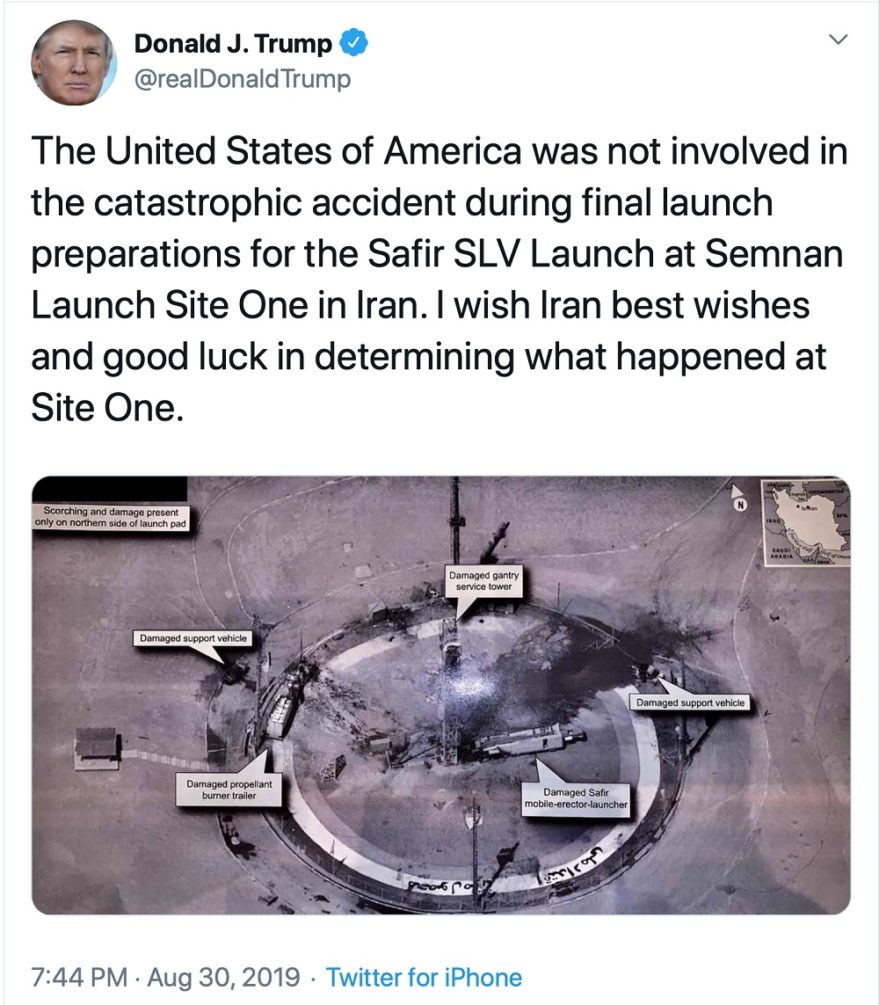What if a company could sell the type of high-resolution imagery President Trump tweeted showing a heavily damaged Iranian launchpad? Would there be a commercial market for Earth imagery with a resolution of 10 centimeters?
The answer was an unequivocal yes from Earth observation experts attending the World Satellite Business Week conference in Paris in September. They cautioned, however, that companies are unlikely to adopt that business plan in the near future due to the high cost of gathering the imagery and government regulations prohibiting its sale.
“We would absolutely go there if it was affordable,” said Scott Herman, chief technology officer for BlackSky, a Spaceflight Industries subsidiary. “But if it costs $2 billion for the satellite to obtain that resolution, how would you make that back in the commercial market?”
Earth observation executives estimated it would cost between $1 billion and $2 billion to build and launch a satellite with a 2.4-meter mirror like the Hubble Space Telescope. A Hubble-sized telescope pointed at Earth would produce imagery with a resolution of 10 centimeter or better.
“It would be great for a lot of applications,” said Emiliano Kargieman, founder and CEO of Satellogic, a satellite operator and geospatial analytics firm based in Buenos Aires, Argentina.
In the agriculture market, for example, there are different applications for satellite imagery with resolutions of 10 meters and one meter as well as 10 centimeter imagery captured by drones.
If a company could charge customers 10 cents per hectare for 10-centimeter satellite imagery, the market would be strong, Kargieman said. But that would not be the case“if you are going to charge them $100,000 a hectare,” he added.
Herman agreed 10-centimeter satellite imagery would “open up a tremendous number of use cases.”
For example, companies could observe distant manufacturing plants. Today, they rely on drones to get a close-up view of parts being installed during plant construction and inventory lined up in piles outside. “But drones don’t scale to offer global views,” Herman said.
 U.S. companies currently are prohibited by the National Oceanic and Atmospheric Administration’s licensing process from selling satellite imagery commercially with a resolution of 10 centimeters. Maxar sells 25-centimeter imagery commercially and supplies higher-resolution imagery to the U.S. government. U.S. allies place similar restrictions on commercial imagery sales.
U.S. companies currently are prohibited by the National Oceanic and Atmospheric Administration’s licensing process from selling satellite imagery commercially with a resolution of 10 centimeters. Maxar sells 25-centimeter imagery commercially and supplies higher-resolution imagery to the U.S. government. U.S. allies place similar restrictions on commercial imagery sales.
Before a U.S. company would invest in a satellite to capture 10-centimeter imagery, those restrictions would need to eased, Herman said.
“At some point if the technology becomes commercially viable, the lobbying required to get the regulations eased could happen,” Herman said. Companies would argue for new rules by noting that drones already capture the high-resolution views and that unless the rules are changed countries like China could beat U.S. industry to the market, he said.
Without any modifications to regulations, companies could sell 10-centimeter or better imagery to the U.S. government, which gathers its own imagery with classified reconnaissance satellites including the Keyhole constellation. Intelligence experts point to the Keyhole constellation as the likely source of the imagery tweeted by Trump.
However, companies are not likely to spend money building and launching satellites to acquire that imagery unless they know they can recoup the investment, said Matt O’Connell, Seraphim Capital managing partner and former CEO of GeoEye, a satellite imaging firm that merged with DigitalGlobe in 2013.
The U.S. government passes annual budgets rather than making long-term funding commitments. If the government wants a commercial source for 10-centimeter imagery, it would need to offer companies assurance in the form of termination liability, a guaranteed payment if the government establishes a program to acquire the high-resolution imagery and then cancels it.
“The government has never given the commercial satellite imagery industry the same termination liability it gives other military contractors,” O’Connell said. “It would be hard for a company to accept the risk of making considerable cash outlays unless they had termination liability like the prime contractors get for building jets.”
This article originally appeared in the Sept. 23, 2019 issue of SpaceNews magazine.
#Space | https://sciencespies.com/space/is-there-a-commercial-market-for-keyhole-class-imagery-like-trump-tweeted/
No comments:
Post a Comment